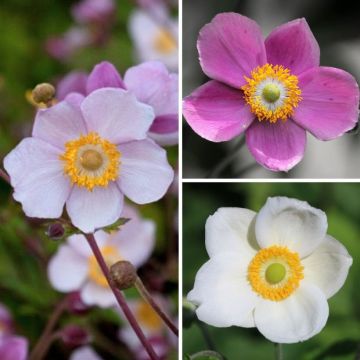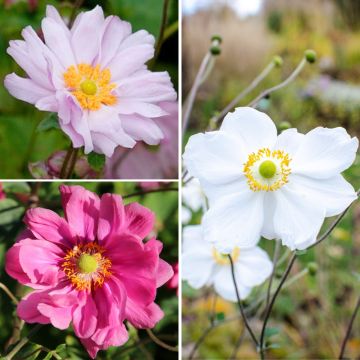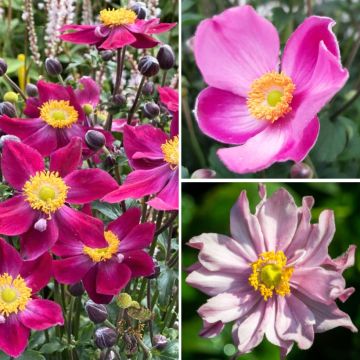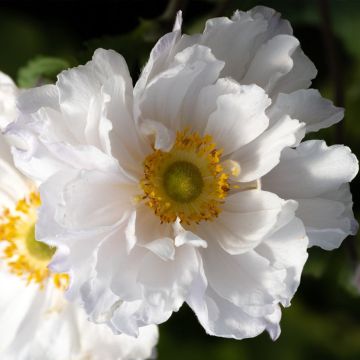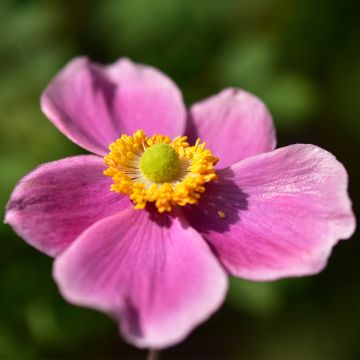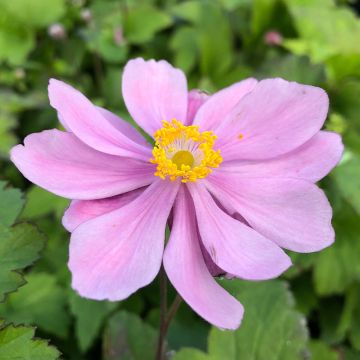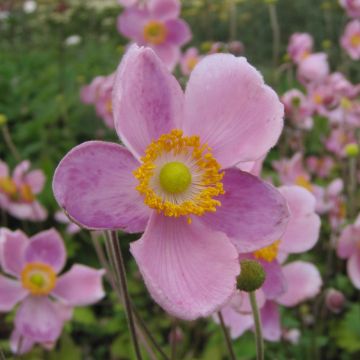
Japanese anemones: planting and care
Contents
Japanese Anemones, in a nutshell
- Japanese Anemone is one of the most beautiful late summer flowers for partial shade.
- Its bright, fully open flowers sway on their long stems.
- Easy to grow and remarkably vigorous, Anemone x hupehensis fears only excessive moisture and overly dry conditions.
- Highly floriferous and perennial, it is a great asset in late-season gardens.
- Low-maintenance, once well established, it lives its life!
- It is a must-have in English and natural gardens. Iconic, Japanese Anemone is our favourite flower for autumn scenes.
A word from our Expert
Japanese Anemones or Autumn Anemones and their hybrids are remarkable for their abundant flowering. They suit many garden styles, from the most classic to the most modern. They have become very popular in recent years among landscapers; a fine example is provided by the fields of Anemones designed by Gilles Clément for the garden of the Musée du Quai Branly in Paris.
Autumn Anemones are among the most enduring perennial plants for partial shade. Easy to grow, they ensure a very floral end of summer and autumn each year, with a profusion of large single or double flowers, white or pink in varying shades, sometimes leaning towards purple. They thrive in partial shade, at the foot of trees or at the back of borders where they form magnificent colonies. Very hardy, they grow in cool soil, without too much lime, where they spread slowly but surely. They take a few years to really settle in, but once they find their place in the garden, their flowers become increasingly numerous over the years. Japanese Anemone can become invasive, so it needs to be controlled a bit, unless you enjoy the naturalistic look!
These “daughters of the air,” both light, resilient, and low-maintenance, are essential for autumn scenes. They easily combine with other perennials and late-flowering roses, creating very lovely simple and fresh bouquets.
Botany
Botanical data
- Latin name Anemone hupenhensis var. japonica, Anemone x hybrida
- Family Ranunculaceae
- Common name Japanese Anemone, Autumn Anemone
- Flowering From August to November, flowers 5 to 10 cm in diameter
- Height 0.40 to 1.50 m
- Exposure Non-burning sun, partial shade, shade
- Soil type Rich, humus-bearing, cool, light and well-drained
- Hardiness Below -15 °C
Japanese Anemones or Autumn Anemones belong to the family of Ranunculaceae. They are mainly found in temperate and cold regions of our hemisphere. They grow naturally in light shade woods and moist meadows.
Japanese Anemones are primarily derived from A. hupehensis var. japonica, native to central and western China, with numerous narrow petals, and A. vitifolia, which originates from the Himalayas. Their hybrid A. x hybrida and its cultivars are among the most sought after by gardening enthusiasts.
Regardless of soil type, the Anemone is very tolerant; it prefers cool soils but does not tolerate wet soils well, especially when young.
Opt for a not too hot exposure, avoiding calcareous soils which they do not tolerate well. They can withstand brief periods of drought and can handle the non-burning sun of the morning or late afternoon but prefer partial shade. Japanese Anemones thrive in partial shade at the base of trees that provide them with coolness and allow them to flourish. However, they do not like overly dense shade: do not place them in competition with bushes that could deprive them of light. They also need air!
The medium to dark green foliage, very abundant at the base, is deciduous, highly dissected, strongly veined on the underside, and more or less pubescent. It appears quite late in spring, allowing for the association of Japanese Anemones with bulbous plants that will occupy the space early in the season. The large rounded to ovate leaves, measuring 10 to 20 cm long, are divided into three lobes.
The Japanese Anemone has an upright habit and forms large clumps, vigorous and rounded, more or less compact, from 0.40 to 1.50 m high depending on the variety. The width at maturity is highly variable, from 50 cm to infinity if left to thrive… The stems dry out with the cold and should be removed from the stump; the clump is generally cut back to the base at the end of autumn.
As it grows, this perennial with fibrous tubers produces very brittle rootlets that will sucker. The Japanese Anemone takes a little time to establish: in the first year, the plant slowly develops its roots in the soil, and it is only in the second year that it truly begins to flower and also to sucker. It then spreads spontaneously.

Japanese Anemone: in bud, in flower, in seed
Even when left unattended, Japanese Anemones propagate through their suckers. Eventually, they can occupy the entire space allotted, forming beautiful colonies. Although somewhat invasive, they do not smother their neighbours but weave among others in a very natural way. It is better to have a nice space planned for them! If you wish to limit their spread, do not hesitate to encircle the clump. When grown in ideal conditions, they can live for decades. And, the longer they are in place, the more abundant their flowering becomes.
The flowering is the main attraction of Japanese Anemones. Sturdy, slender, and straight flower stems rise to 60 cm for the smaller varieties, and up to 1.50 m high for Anemones x hybrida, bearing umbels of 15 to 20 flowers. For the tallest varieties reaching over 1 m, staking is sometimes necessary due to the weight of the flowers. Cultivars derived from Anemone hupehensis var. japonica have many more petals. The flowers, measuring 5 to 10 cm in diameter, are solitary or grouped in cymes or umbels on branched stems.

The Japanese Anemone is one of the prettiest flowers of autumn. Light and graceful, it sways with the wind, indifferent to the first frosts. Touching in its simplicity, it charms us with its elegance and bright, well-opened flowers that illuminate shaded corners.
Japanese Anemones come in white flowers or in an infinite array of vibrant or pastel shades of pink, sometimes even purplish or reddish, often with single flowers and sometimes with double flowers. They are also more or less complex with a variable number of petals (or similar, tepals). They first appear as delightful oval and fluffy buds, then bloom into flat or flared cups, with 5 to 20 tepals or more, narrow or wide, sometimes hollowed, sometimes twisted (26 for Anemone hupehensis var. japonica ‘Pamina’) that spread around a heart bordered with golden stamens. Not fragrant, they more than compensate for this lack of scent with their remarkable floribundity. Once the flower has faded, only a cotton ball remains, very poetic in a dry bouquet.
Japanese Anemones bloom from late summer to autumn. The flowering lasts a good month (dwarf varieties up to a month and a half), and each flower lasts 4 to 5 days.
Avoid overly drying exposures and you will be dazzled each year by a profusion of large flowers that appear in August, the last being taken by the frosts.
Autumn Anemones make very beautiful airy bouquets thanks to their straight and fine stems, with well-opened corollas and flowers still in bud. Perfect for rustic and romantic bouquets, combined with grasses and cinerarias or umbellifers.
For your bouquets, prioritise the flowers that are almost closed or in the process of blooming because, once in water, they continue to open. The Anemone has good longevity (about 10 days). If you pick it already in bloom, it only lasts 4 days.
And for your winter bouquets, do not hesitate to cut and vase the stems bearing the seed capsules that seem dry; after 2 hours at room temperature, you will see white aments that look like cotton.
The main varieties
There are dozens of varieties of Japanese Anemones. There is indeed some confusion in their classification: some cultivars have been given a new name while their original name was still valid. Thus, ‘Albert Schweitzer’ and ‘Max Vogel’ are none other than the Anemone x hybrida ‘Elegans’, the plants sold under the name ‘Luise Uhink’ are actually either ‘Honorine Jobert’ or ‘Whirlwind’, and ‘Bressingham Glow’ is identical to ‘Prinz Heinrich’.
The main criteria for selection are the colour and shape of the flowers, as well as the height, with some varieties like Anemone x hybrida ‘Monterosa’ reaching 1.25 m.
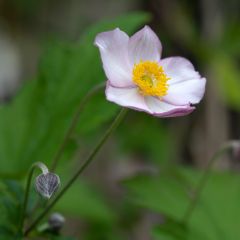
Anemone hybrida Hadspen Abundance
- Flowering time September to November
- Height at maturity 80 cm
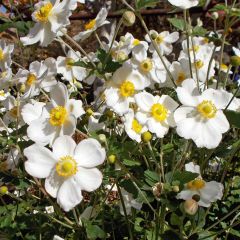
Anemone hybrida Honorine Jobert
- Flowering time September to November
- Height at maturity 1,20 m
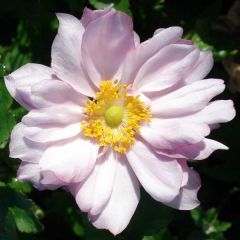
Anemone hybrida Königin Charlotte
- Flowering time September to November
- Height at maturity 1 m
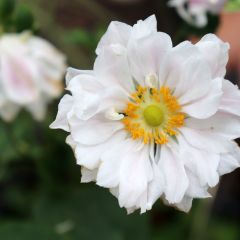
Anemone hybrida Whirlwind
- Flowering time September to November
- Height at maturity 1,20 m
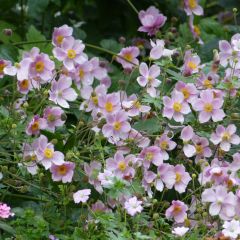
Anemone hupehensis September Charm
- Flowering time September to November
- Height at maturity 1 m

Anemone hybrida Bressingham Glow
- Flowering time September to November
- Height at maturity 70 cm
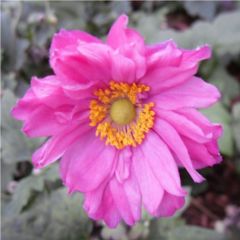
Anemone hupehensis var. japonica Prinz Heinrich
- Flowering time August to November
- Height at maturity 70 cm

Anemone hupehensis var. japonica Little Princess
- Flowering time September to December
- Height at maturity 50 cm
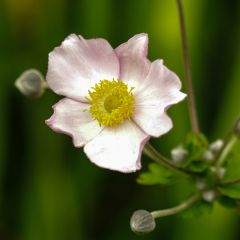
Anemone tomentosa Robustissima
- Flowering time September to November
- Height at maturity 1 m
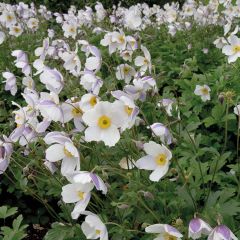
Anemone Wild Swan - Japanese Anemone
- Flowering time July to November
- Height at maturity 50 cm
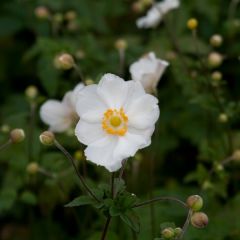
Anemone hybrida Andrea Atkinson
- Flowering time September to November
- Height at maturity 1,20 m
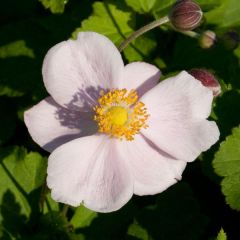
Anemone hybrida Richard Ahrens
- Flowering time September to November
- Height at maturity 1 m
Anemone hybrida Mont Rose
- Flowering time September to November
- Height at maturity 60 cm
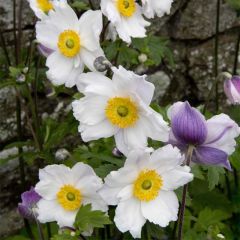
Anemone Ruffled Swan - Japanese Anemone
- Flowering time July to November
- Height at maturity 75 cm

Anemone hupehensis var. japonica Fantasy Pocahontas
- Flowering time September to December
- Height at maturity 45 cm
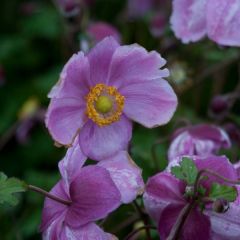
Anemone hybrida Rosenschale
- Flowering time September to November
- Height at maturity 1,20 m
Discover other Japanese Anemones
View all →Available in 0 sizes
Available in 0 sizes
Available in 0 sizes
Available in 1 sizes
Available in 3 sizes
Available in 3 sizes
Available in 1 sizes
Available in 1 sizes
Available in 4 sizes
Available in 1 sizes
Planting Japanese Anemones
Where to Plant Japanese Anemones?
The Japanese Anemone is not a particularly complicated plant. It’s a good-natured plant: when planted in suitable soil, it blooms for many years without requiring much maintenance. It can be found in various locations across France, except in Mediterranean climates.
It prefers to be planted in partial shade, with exposure to morning or late afternoon sun, or under dappled sunlight from trees: avoid the midday sun from 12 to 2 PM, which tends to scorch the foliage. We recommend planting it sheltered from the scorching sun in the partial shade of a hedge or under the light shade of a tree. It does not like overly dense shade. In your borders, do not place it too close to bushes that might deprive it of light. Opt for varieties with double and low flowers at the edge of a border, to line a pathway. Position the taller varieties at the back of the border.
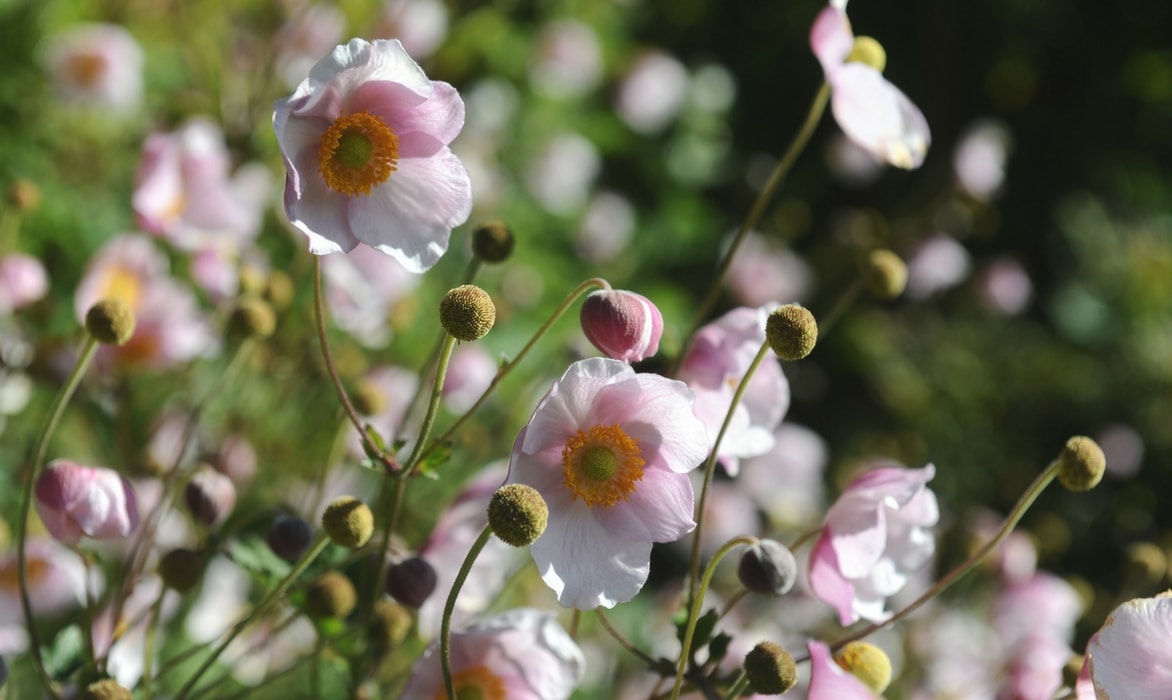
The Anemone does not really tolerate lime, so plant it in neutral or acidic soil, preferably light and rich in humus, where it spreads slowly using its underground rootstocks. Soils that are too alkaline will cause the foliage to yellow.
To thrive and bloom well, the Japanese Anemone needs fresh to moist, loose, and well-drained soil: while it tolerates a wide range of soils (except perhaps very poor and stony ones), it prefers humus-bearing soils, like those found in woodlands. If your soil is really heavy or clayey, add compost to lighten it. It does not tolerate waterlogged soils in winter. While it can withstand a spell of summer drought, prolonged dryness will kill it.
It is a hardy perennial that can easily withstand temperatures below -15 °C, sometimes down to -20 °C but only for a short duration. It does not fear cold climates, but in regions with harsh winters, cover young plants with a protective mulch of straw or fallen leaves to retain soil moisture and protect the stump from winter cold.
It is better to give it a spot sheltered from strong winds that could flatten the clumps.
The Japanese Anemone grows very well in pots, (in a deep container of at least 30 cm). Opt for sturdy varieties like Fantasy Pocahontas to plant alone or combined with grasses, stipas, dahlias, phlox, or asters, favouring soft hues. In pots, you can provide a balanced fertiliser rich in potash and phosphorus each year.
When to Plant?
Japanese Anemones are planted in spring (March-April) or in autumn (September-early October), when temperatures are mild. These periods allow the plants to establish their roots well before the harsh winter frosts or summer heat, ensuring better recovery.
How to Plant Japanese Anemones?
The Japanese Anemone is a slow-to-establish plant with delicate roots. The main difficulty in its cultivation lies in its recovery at the time of planting. Fresh to moist, deep, and well-drained soil is essential to promote its development.
- Dig a hole twice as wide and slightly deeper than the plant’s bucket.
- If your soil is heavy or clayey, add compost or well-decomposed organic matter to the bottom of the hole to improve drainage.
- Position the root ball of the Anemone in the hole so that the collar is level with the soil surface.
- Fill around the root ball with a mixture of soil and compost, then lightly firm it down.
- Water generously after planting to help the root ball adhere well to the surrounding soil.
The recommended spacing is 30 to 50 cm between each plant, with a density of 2 to 5 plants per m² to achieve a dense visual effect in your borders. This plant is quite light and not very compact, so planting in numbers creates a better visual impact.
Once the young plants are established, avoid moving them as their roots are sensitive to disturbance. You will need to wait until the second year for the Anemone to start producing suckers and blooming abundantly. Once well established, it will gradually form colonies, spreading through its underground suckers. If you prefer well-ordered borders, dig a trench 25 cm deep around the base of the anemone, slide in a barrier, and encircle the clump to prevent it from spreading.
During the first year, water regularly to keep the soil moist, but avoid excess moisture, which could rot the roots, especially in young plants. During dry periods, weekly watering is recommended for the first two months after planting. After that, you can space watering to once every 15 days if the climate remains favourable.
In winter, the foliage of the anemones completely disappears. If you have planted them in isolation, it is wise to place a small marker near the base to avoid damaging the roots during soil maintenance work in the cold season.
How to care for Japanese Anemones?
These are ideal plants for gardeners with little time to devote to their borders. Japanese Anemone is a carefree plant that is resistant to diseases and pests. It has no significant enemies.
In spring, the young shoots are sometimes attacked by slugs and later by nematodes. The solution: against slugs, spread a barrier of ash around the anemone plants or borders.
It may occasionally experience attacks of rust, downy mildew, or “smut,” but generally without severity.
To ensure generous flowering, add well-decomposed compost at the base of the plant every 2 to 3 years, preferably in early spring, as the anemone is relatively greedy.
Remove faded flowers as they appear to encourage the emergence of new blooms. Under the weight of the flowers, the stems of some larger specimens may break: staking may be necessary.
Cut back the flower stems and foliage to ground level in early winter. In regions with harsh winters, cover the plant with a protective mulch of straw or fallen leaves.
Japanese Anemone tends to spread and can become invasive. If you wish to limit its growth, regularly weed around the plants to contain its spread.
How to propagate Japanese Anemone?
Sowing
It is not recommended, as the germination of seeds is slow and irregular, offering very variable results.
Division
In contrast to sowing, the division of Japanese Anemones is easy and risk-free. Divide well-established clumps, generally after 3 years of cultivation. In March, using a garden fork, separate the main stump into 3 to 5 pieces, which you will replant immediately in the ground at 30 cm apart. Expect one to two years before the first flowering.
Propagation by cuttings
Japanese Anemones can be reproduced by cuttings taken in autumn from the roots that develop at the edge of the clump. This operation is very simple and allows you to obtain additional plants from an already well-established plant in the ground or by recovering roots from a beautiful specimen you have just purchased.
- In September-October, take a 10 cm wide clump of Anemone roots
- Cut it into two or three parts
- Plant these pieces in a seed tray of sandy compost.
- Leave everything to rest in a dry place.
- Monitor and if it’s too dry, water a little.
- Repot the cuttings the following spring in buckets with potting soil before replanting them in the ground.
- Count on average one to two years before seeing the first flowering.
→ Learn more about the division of Japanese anemones in our tutorial! Also discover our tips on root cuttings of Japanese anemones.
How to pair Japanese Anemone?
Japanese anemone brightens late summer and early autumn borders with its delicate and graceful flowers. Versatile, it fits beautifully into both contemporary gardens and more traditional borders, adding a touch of elegance and poetry. Its tall and light habit makes it a perfect companion for robust perennials, creating rich scenes full of contrasts and volumes.
It is a must-have in English Cottage gardens, where it pairs wonderfully with old roses and other late-flowering perennials, such as asters or sedums. Together, they create fresh and romantic combinations in soft shades of white, pink, and mauve. In addition to these pastel hues, the anemone also pairs very well with darker foliage, such as that of heucheras or hostas, which highlight its airy flowering.
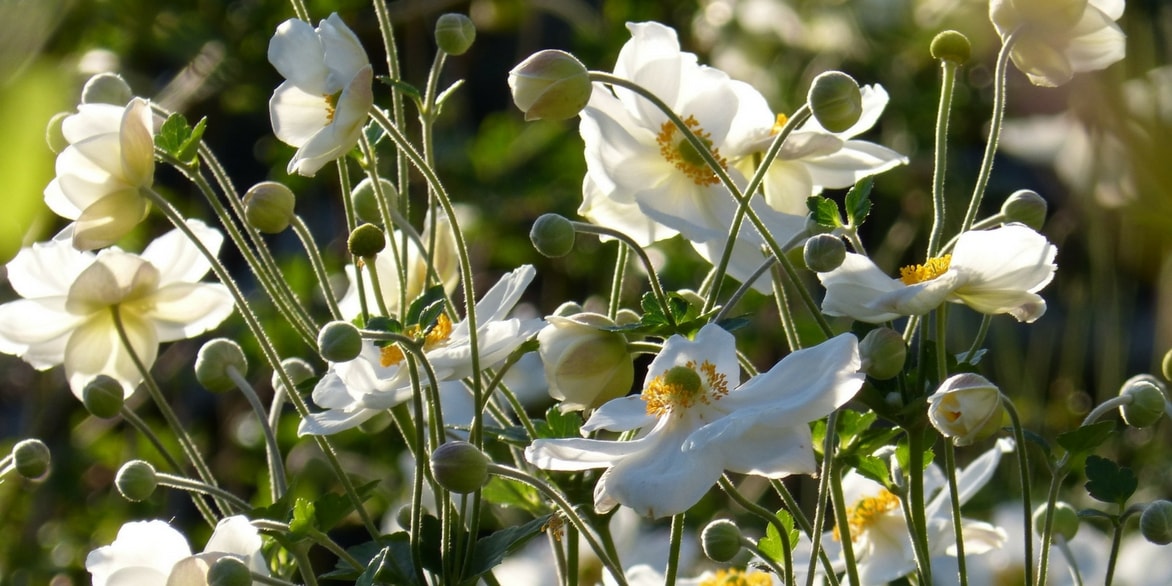
In shady gardens, it is one of the centrepieces, capable of bringing light with its pale flowers. It is also a flagship plant of ‘white gardens’, where it creates soothing and sophisticated compositions. Its adaptable character allows it to be grown both in the ground, in borders, and in large pots on a terrace, where it continues to bloom generously until the first frosts.
For a more natural effect, you can pair it with ornamental grasses, such as miscanthus or stipas, which will emphasise its light and dancing quality in the wind. Whatever the style of the garden, Japanese anemone brings a subtle yet remarkable presence, offering a smooth transition between summer and autumn.
To learn how to pair it well in the garden, discover our advice sheet: “Japanese Anemones: 8 Ideas for Successful Pairings”
Useful resources
- The most beautiful varieties of Japanese Anemone available on our site.
- Our advice sheet: Mulching: why and how?
- Our advice sheet: White-flowered Japanese Anemones: 10 varieties to discover
- Our advice sheet: Japanese Anemones, 10 varieties for pot cultivation
- Our advice sheet: Choosing a Japanese Anemone
- Our advice sheet: Japanese Anemones, the most beautiful varieties
- Our advice sheet: Pink-flowered Japanese Anemones: 10 varieties to discover
- Discover our 5 favourite varieties of double-flowered Japanese Anemones
- Our advice sheet: 5 Japanese Anemones for the back of the border
- Also discover our advice sheet on slow-to-establish plants
Frequently asked questions
-
I have anemone plants under a lilac, and they tend to spread throughout the bed. What should I do?
It's normal. As it grows, the Anemone forms colonies and can become invasive. When the plant is established in good conditions, it multiplies and spreads. If you wish to limit its growth, there are two options: simply weed it out or dig a trench 25 cm deep around its base, slide in a tarp, and encircle the clump to prevent it from spreading.
-
My young Japanese Anemone plant hasn't flowered this year, is that normal?
Be patient, it's normal. Japanese Anemones take a few years to really settle in. Generally, they need at least 2 years, or even a bit more, to reach optimum development. But after that, the more years go by, the more floriferous they will be!
-
My Anemone hupehensis is no longer flowering? Why?
It is not normal, especially if it is a well-established young plant. If it does not flower, it is generally because it lacks water: either the soil is too dry or it is too sunny. Humidity must not be lacking during the flowering period. The solution: mulch and water regularly. Another possible cause is planting in a location that is too dark, with thick shade and no sunlight at all. This plant prefers to be planted in partial shade, with exposure to sunlight in the morning or late afternoon, or under dappled sunlight from trees: it does not like dense shade. You may need to consider moving it, at the end of winter, to a sunnier area.
-
My young plant of autumn Anemone has rotted, what is the reason?
In the first year following planting, there is sometimes a tendency to overwater, and in overly moist soil, the roots can rot. Keep the soil cool, meaning moist but without excess water.
- Subscribe!
- Contents































